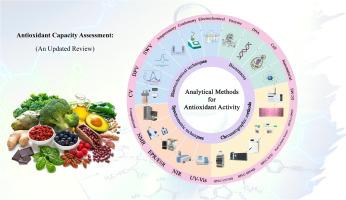Analytical methodologies for antioxidant capacity assessment: An updated review
IF 3.7
Q1 CHEMISTRY, ANALYTICAL
引用次数: 0
Abstract
Antioxidants are crucial molecules protecting biological systems from harmful oxidation reactions and free radicals. This class of compounds attracted remarkable attention for their potential in functional foods and dietary supplements. The imbalance between oxidants and antioxidants leads to oxidative stress, associated with various chronic diseases. Accurate measurement of antioxidant activity is therefore essential for evaluating potential health-enhancing agents in food science, medicine, and biotechnology. This review provides a comprehensive overview of contemporary analytical methodologies for assessing antioxidant capacity across food, cosmetic, pharmaceutical, and biomedical applications, exploring four major categories of techniques: spectrophotometric methods, including UV–Vis, electron paramagnetic resonance (EPR), and near infrared (NIR) spectroscopy, highlighting their principles and applications in radical scavenging assays and antioxidant characterization. Electrochemical techniques are rapid, sensitive, and cost-effective alternatives, focusing on voltammetry, amperometry, and biosensor development for direct measurement of electron transfer processes. The role of biosensors, employing bioreceptors like enzymes and DNA, for selective and sensitive antioxidant detection is also examined. Chromatographic methods, such as high-performance liquid chromatography (HPLC) and gas chromatography (GC), paired with selective detectors, are used to separate, identify, and quantify antioxidant compounds in complex matrices. This review highlights the principles, advancements, advantages, and limitations of these diverse methodologies in the accurate evaluation of antioxidant potential.

抗氧化能力评估的分析方法:最新综述
抗氧化剂是保护生物系统免受有害氧化反应和自由基侵害的关键分子。这类化合物因其在功能性食品和膳食补充剂中的潜力而备受关注。氧化剂和抗氧化剂之间的不平衡导致氧化应激,与各种慢性疾病有关。因此,准确测量抗氧化活性对于评估食品科学、医学和生物技术中潜在的健康促进剂至关重要。本文综述了食品、化妆品、制药和生物医学领域抗氧化能力评估的现代分析方法,探讨了四大类技术:分光光度法,包括紫外-可见、电子顺磁共振(EPR)和近红外(NIR)光谱,重点介绍了它们在自由基清除试验和抗氧化表征中的原理和应用。电化学技术是一种快速、灵敏、经济的替代方法,主要集中在伏安法、安培法和生物传感器的开发上,用于直接测量电子转移过程。生物传感器的作用,采用生物受体如酶和DNA,选择性和敏感的抗氧化剂检测也进行了检查。色谱方法,如高效液相色谱(HPLC)和气相色谱(GC),与选择性检测器配对,用于分离、鉴定和定量复杂基质中的抗氧化化合物。本文综述了这些不同方法在准确评价抗氧化潜力方面的原理、进展、优势和局限性。
本文章由计算机程序翻译,如有差异,请以英文原文为准。
求助全文
约1分钟内获得全文
求助全文

 求助内容:
求助内容: 应助结果提醒方式:
应助结果提醒方式:


